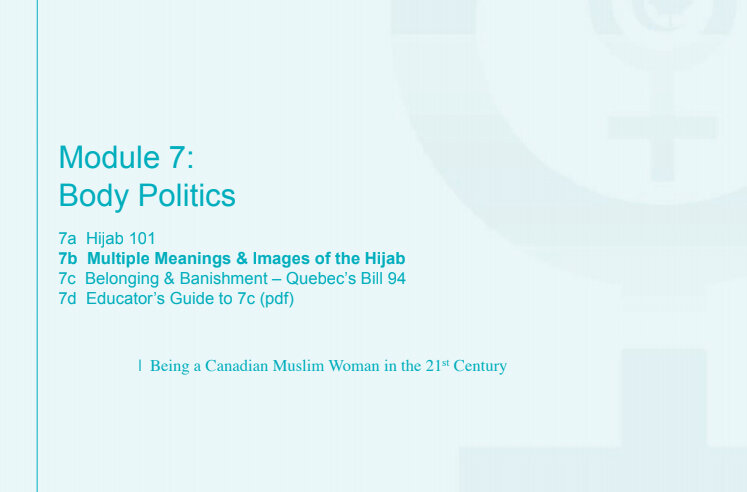Being A Canadian Muslim Woman in the 21st Century
This educational resource kit is part of the Canadian Council of Muslim Women’s (CCMW) project, Being a Canadian Muslim Woman in the 21st Century. The objectives of the project are twofold:
increase the understanding on the part of the education system of the issues and challenges facing young Muslim women (age 14-18)
develop resources that can be used by educators who work with young Muslim women
This educational resource kit is part of the Canadian Council of Muslim Women’s (CCMW) project, Being a Canadian Muslim Woman in the 21st Century. The objectives of the project are twofold:
increase the understanding on the part of the education system of the issues and challenges facing young Muslim women (age 14-18)
develop resources that can be used by educators who work with young Muslim women
We have anecdotal evidence about the stress and conflicts facing young Muslim women, such as racism/discrimination, clash of family and broader societal values, and the tensions in developing an identity that includes their multiple characteristics. Many of these young women are children of recent immigrants and are grappling with adaptation issues such as the integration of culture and religion in their lives. In schools, educators and other students often do not understand the issues that young Muslim women are dealing with. Two recent incidents demonstrate the need for action to overcome this lack of understanding: the killing of a young Muslim woman in Mississauga by her father and brother, and the alleged sexual abuse of a female Muslim student at a Toronto high school, which only came to light because of other problems at the school.
As schools play a vital role in young people’s lives, CCMW believes it is in school settings that issues can be addressed.
This kit has a total of 8 modules and covers a broad range of issues, including, for example, violence against women and children, stereotyping of Muslim women, the politics of representation, and racism/discrimination. Each module also has specific learning objectives. These are listed in the curriculum overview along with suggestions of courses in which the module can be used. Each module can stand alone, and therefore users of the kit can pick and choose the modules relevant for their specific purpose.
While the kit is primarily aimed at educators and meant for use by teachers in the classroom, there are other potential uses of the information presented in the kit. For example, it can be used to sensitize social service providers and other front line workers to the issues and challenges faced by young Muslim women.
Educators as Facilitators
There’s inevitably will be diverse opinions among students regarding many of the issues raised in the Being a Canadian Muslim Woman in the 21st Century curriculum. Educators must be conscious of how their position of power and authority as educators can influence their students’ understanding of and engagement with the curriculum. It is important for educators to not let their personal opinions, beliefs and values determine how the information and issues are presented and taken up with students. Instead, educators should present the material in ways that allow for classroom discussions to unfold organically among students. The main role of educators using the Being a Canadian Muslim Woman in the 21st Century project curriculum is to serve as a facilitator.
Facilitating discussions on issues which are extremely personal and political will mean that educators will be faced with having to manage conflicting ideas and opinions among students. In fostering open and honest exchange of ideas among students it is important for educators to create and maintain a safe, non-combative atmosphere that allows for differences of perspective in the spirit of increasing understanding of the issues and challenges facing young Muslim women. It is not the place of educators to offer definitive conclusions to the issues raised based on their own opinion, beliefs, and values. Educators should anticipate that there will be disagreement among students about what constitutes Muslim identity and the representation of Muslim identities. The curriculum provides a wide diversity of information, images and questions that will allow for students and educators to engage in a rich discussion on the varied ways in which Muslim women define themselves with respect to their faith and other aspects of their identity. It should be noted that the examples of Muslim women included in Being a Canadian Muslim Woman in the 21st Century curriculum were selected not for how others view their identity as Muslim women, but based on their own self-identification as Muslim women. So while there may be challenges from students who question whether or not the women profiled are representative of Muslim women, it is important for educators not to debate this point but rather point out that these women are being showcased because they self-identify as Muslim women.
CCMW would like to thank Dr. Jasmin Zine and Dr. Zabedia Nazim for developing this kit, and acknowledges the contribution of members of the CCMW Advisory Committee who guided us throughout the kit-development process. They include: Rehnna Begg, Salima Bhimani, Sameena Eidoo, Zahra Grant, Rizwana Jafri, Nina Karachi, Farrah Khan and Barbara Siddiqui.
Jasmin Zine and Zabedia Nazim would like to acknowledge the contributions of Humera Javed, Krista Riley, Asma Bala and Itrath Syed to this curriculum tool kit.We are grateful for their assistance and creativity in developing the activities and resources. We would also like to thank the project advisory committee for their feedback and comments.












